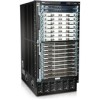Dell PowerConnect J-8216 Hardware Guide - Page 29
Routing Engine and Control Redundancy, Switch Fabric Redundancy
 |
View all Dell PowerConnect J-8216 manuals
Add to My Manuals
Save this manual to your list of manuals |
Page 29 highlights
Chapter 1: Dell PowerConnect J-Series J-EX8216 Switch Overview Each fan tray continues to operate indefinitely and provide sufficient cooling even when a single fan fails provided the room temperature is within the operating range. See "Cooling System and Airflow in a J-EX8216 Switch" on page 44. Routing Engine and Control Redundancy Each RE module contains Routing Engine circuitry, and system control and management circuitry. A redundant J-EX8216 switch has two RE modules. When a switch has two RE modules, one functions as the master while the other functions as a backup and is in standby mode. This provides the switch with full redundancy (1+1) for Routing Engine and system control functionality. Table 6 on page 13 lists the RE module slots in the J-EX8216 chassis and the Routing Engine and associated system control redundancy. Table 6: Routing Engine and System Control Redundancy for J-EX8216 Switches Switch Configuration Slot RE0 Slot RE1 Routing Engine and System Control Redundancy Redundant configuration RE module RE module Yes Switch Fabric Redundancy The switch fabric circuitry in a J-EX8216 switch is distributed across eight Switch Fabric (SF) modules. We recommend that you install all eight SF modules in a J-EX8216 switch to support maximum midplane performance for the installed line cards. All SF modules are fully connected to all installed line cards. When the switch is operational, all eight SF modules are simultaneously active. If a single SF module fails, the input/output traffic for that module is load-balanced among the remaining SF modules, providing graceful degradation in midplane performance. The impact of an SF module failure on the performance of a J-EX8216 switch varies based on the type of line cards installed in the switch and the traffic mix flowing through them. In a J-EX8216 switch configuration that is fully loaded with 8-port 10-Gigabit Ethernet SFP+ line cards, if one SF module fails, the remaining seven SF modules still have sufficient switching capacity to maintain continuous switch operation at full wire-rate performance. Table 7 on page 13 lists the SF module slots in a J-EX8216 chassis and shows that switch fabric redundancy is associated with the redundant switch configuration. Table 7: Switch Fabric Redundancy for J-EX8216 Switches Switch Configuration Slots SF7 Through SF0 Switch Fabric Redundancy Redundant configuration SF modules installed in all slots Yes Related • Routing Engine (RE) Module in a J-EX8216 Switch on page 26 Documentation • Switch Fabric (SF) Modules in a J-EX8216 Switch on page 29 13















